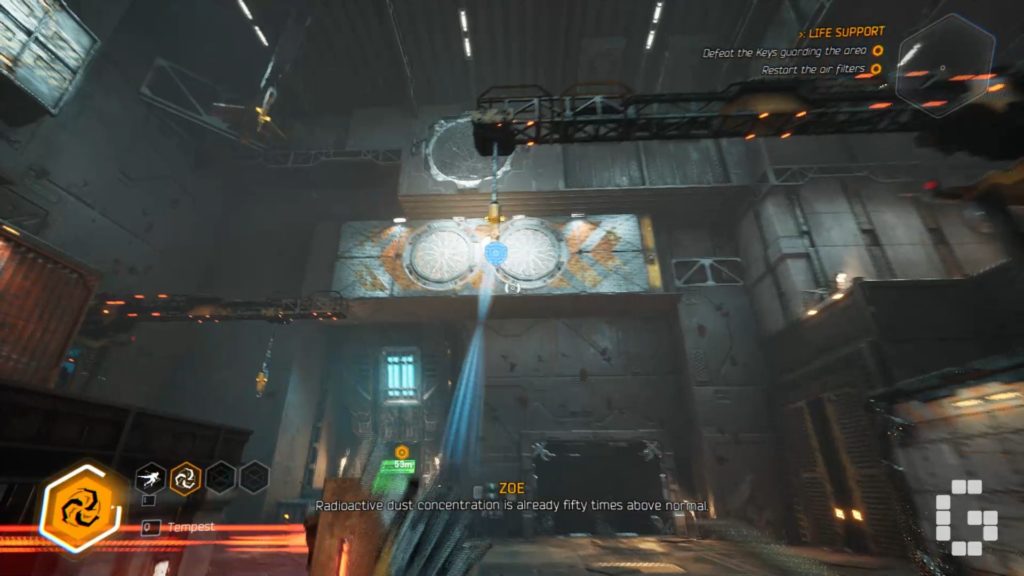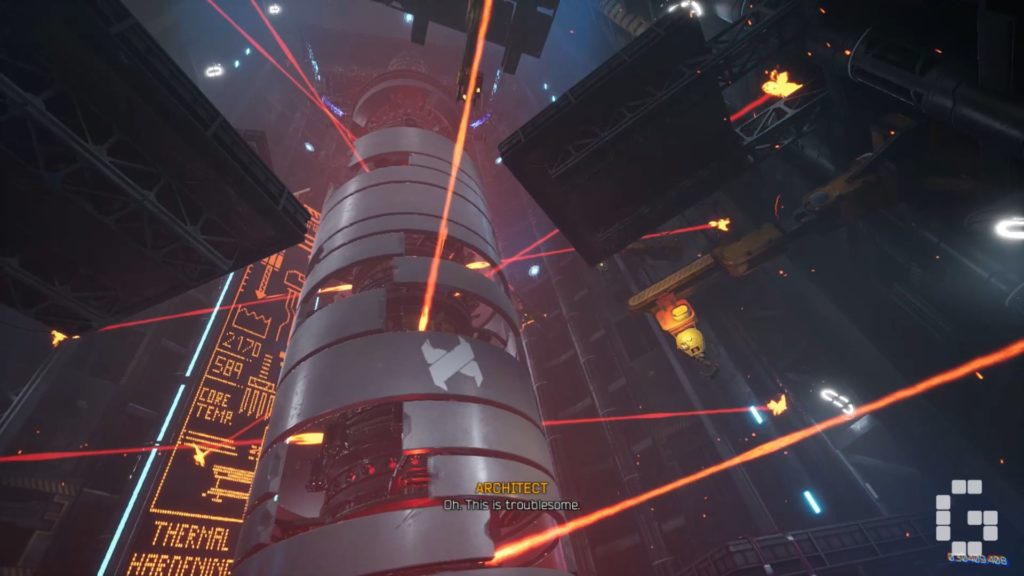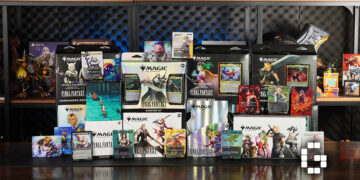Uprisings, cybernetics and a techno-ambience. These are the pre-requisites of the future, as per every piece of cyberpunk media. Ghostrunner is yet another entry in the growing genre, where you must scale the massive Dharma Tower and save the city from the evil Keymaster.
You do this by using the sacred martial art of the oppressed- parkour. Of course, scaling walls never really killed anyone, so you also have a a katana to help kill off your enemies once you parkour your way into stabbing range. We’d previously gotten a taste of the game before, though with such a small scope it was questionable how much of that was representative of the whole ga,e.
So how does Ghostrunner actually stack up? Does it scale new heights of gameplay hitherto unheard of? or does it fumble the running start? Read on to find out.
Setting
Ghostrunner takes place in the Cyberpunk city housed inside Dharma Tower. It’s a really cool concept, with the entire area sitting inside of a glorified skyscraper.
Visually though, it can feel kind of drab. Outside of the game’s penchant for death pits, the game doesn’t actually do anything visually new with its design. Sure, everything technically looks good- full credit to the art team for that- but it has the habit of looking like just another Cyberpunk game.
Even the game’s story isn’t particularly riveting. You are a Ghostrunner, a robot ninja that’s been repurposed by the Rebellion and is now seeking to overthrow the “Keymaster”. You’re also guided by a voice in your head called “The Architect”, the former master of Dharma Tower.
It’s not necessarily a bad story, it just doesn’t feel like it went far enough to really make the story its own. Even the names sound super generic, like it was trying to prove it was part of the genre. While everything looks good, the lack of any real character to the game pulls it down because there’s no real shorthand to describe it since it blends in so well.
That being said, the individual components of the game are great. As previously mentioned, the 3D assets used are top-notch, especially if you love gritty sci-fi. Similarly, the soundtrack is also amazing, fully immersing you with that grungey techno beat. If anything, it’s the lack of ambition on the game’s part to do anything more than just a generic “evil person bad UPRISING is the only way” story that stops the game from registering as anything memorable.

Gameplay
Ghostrunner fits into one of my favorite niches, the action-platformer. Sure, there’s combat encounters, but the combat is just a way to get the adrenaline junkies into the idea of solving puzzles.
With Ghostrunner, mobility feels great. We got a very basic glimpse at the stuff you can do when we tried out the demo a few weeks back. Now that the full game’s out, we get to see just how crazy the Ghostrunner can get with his moveset.
One of my favorite skills the Ghostrunner can use is a timestop. This not only allows you to slow down time, but also allows you to do more complex aerial maneuvers. Considering you die in one hit, it’s a great way to outsmart a bullet that you didn’t initially see coming.
You’ve also got parkour options, as mandatory of the action-platformer genre. These feel really good to do, as they’re very much about getting the timing just right. It’s really helped by the fact this game has an amazing soundtrack, and the beats of the music will often guide you through these platforming sequences.
Probably the most stress-inducing tools you’ll use is the grappling hook. A lot of the grappling points only become visible to you mid-jump. Thanks to Ghostrunner’s corpse-run nature, you’re probably going to end up dying a lot as a result of these, so you’ll need to get to that point where you remember the rhythm of grappling, rather than relying on the visual cue of it.

Combat Puzzles Ahoy!
The game technically has combat, though it’s a lot more similar to the combat encounters of Hotline Miami. That is to say, enemies are simply part of the puzzle, rather than elaborate combat encounters Since you die in one, you’ll need to plan your moves very carefully. This can make a huge disparity in runs- either you gracefully clear a whole platform, or things go laughably bad and you’re back at the checkpoint before you even realized you’d loaded in.
That’s not to say there’s not still fights, though. There’s alot more to the combat than simply not getting shot. The Ghostrunner is capable of timing blocks, in order to reflect bullets back at unfortunate targets-to-be. It’s a great risk-reward, and anyone who says deflecting bullets with a sword isn’t cool is a liar.
There’s also some pretty neat enemy design at play, too. Depending on their guns, enemies will always fire in fixed bursts, meaning you’ll have to keep track if you want to be sure of how safe it is to go before they reload. Some enemies will even have shields that need to be disabled, with hints on the enemy to the direction of the shield.
These are great for mixing up the formula, though it can get a little messy as the levels ramp up in complexity. As it is, expect to be resetting checkpoints a lot while you find the shields.
Speaking of checkpoints, Ghostrunner is thankfully very generous with theirs. Even when you die, you’re rarely ever sent back more than one jump back, better facilitating the corpse run. One minor gripe here is that a lot of audio cues will not continue when you die, so get ready to hear characters talk a LOT as you die and they have to restart their speech.

Boss Fights
Of course, the game wouldn’t be complete without its bossfights. While most combat encounters in the game are quire pleasant, I feel like the boss battles tend to err more towards the annoying side. One of the early bosses is just a pillar of death beams that you need to maneuver around. The sheer amount of beams coming towards you is annoying, especially since there’s no place for you to catch your breath and observe the situation. As it is, even the starting platform is in firing range.
This leads to quite the frustrating encounter, since it’s like the game is breathing down your neck telling you to make decisions without giving you a second to even know what they are yet. I get that you learn on every death but the lack of proper run-up just makes the deaths feel cheap.
That being said, I’m glad the bosses follow the one-and-done rule of the game. Their health is segmented into phases, with certain actions being required to end the phase and getting you a checkpoint. As infuriating as the fights can be, I have to give them credit that they took consideration to make these a little more bearable.
The different phases also play quite differently, which is fun. With platformers especially there’s a danger of just overcomplicating a fight by simply adding new mechanics every phase, so it’s a good thing that the devs took care to not do that.

Customization
Unlike Hotline Miami though, there’s a lot of upgrades at play with. These are done in a particularly unique way, with Tetris-like blocks. representing your abilities. Naturally, more elaborate abilities have more bizarre shapes, so its a test of squeezing in valuable skills.
I actually kind of wish more games would do this. Done well, it’s a very good representation to give players feedback on how they should make their builds. Some of these upgrades are also really good, such as increasing charges on certain abilities.
Of course, the best part about the block system is also that these blocks are removable. You can roll back your upgrades, making sure your Runner has the skills necessary for each encounter as you play them. The flexibility is really appreciated, since the game’s challenges are set in such a way that no skill is going to be universally useful.

Closing Thoughts
As a game, Ghostrunner is great. The gameplay is solid, the visuals are gorgeous and the soundtrack slaps. But I can understand hesitation to get this game thanks to its milquetoast setting and writing. It’s also absolutely a corpse run game, so those of you with limited patience may want to steer clear since dying seems to be a pre-requisite.
For those of you thirsting for a challenge though, Ghostrunner provides in cybernetic spades. Outside of the levels there’s plenty more to do, such as collecting new colorschemes for your Katana. The game’s flexible upgrade system is also great, since you can always give yourself challenges to clear areas.
It’s just a shame that the game couldn’t have rallied its world-building as well as it did its gameplay side.
| Pros | Cons |
| The game looks amazing | Incredibly frustrating if you don’t like corpse runs |
| Solid gameplay | The story is absolutely forgettable |
| Killer soundtrack |
Final Score:
7/10
Review code provided by 505 Games. Game reviewed on a home PC.
Welcome to the future. It's gonna kill you.










![[EXCLUSIVE] Inside Japan’s Indie Game Revolution – An Interview with BitSummit Organizer Masahiko Murakami](https://cdn.gamerbraves.com/2025/05/BitSummit-Orgainzer_Interview_FI-360x180.jpg)
![[EXCLUSIVE] The Art of Adaptation: Developer Interview Details the OVERLORD Mobile RPG Lord of Nazarick](https://cdn.gamerbraves.com/2025/05/Lord-of-Nazarick_Interview_FI-360x180.jpg)
![[EXCLUSIVE] Taking Gundam in Bold New Directions – Interview with GQuuuuuuX Director Kazuya Tsurumaki](https://cdn.gamerbraves.com/2025/04/Kazuya-Tsurumaki_Interview_FI-1-360x180.jpg)


![[SEA Exclusive] From Shadows to Shipwrecks – Jennifer English Talks About Bringing Emotional Depth to Clair Obscur: Expedition 33](https://cdn.gamerbraves.com/2025/04/Clair-Obscur-Jennifer-English_Interview_FI-360x180.jpg)

![[EXCLUSIVE] Do the Game Interview – An Intimate Look at the Challenges of Game Development](https://cdn.gamerbraves.com/2025/04/Do-the-Game_Interview_FI-1-360x180.jpg)
![[EXCLUSIVE] Interview with the Minds Behind of Den of Wolves – 10 Chambers’ New Sci-Fi Heist FPS](https://cdn.gamerbraves.com/2025/04/Den-of-Wolves_Interview_FI-360x180.jpg)









